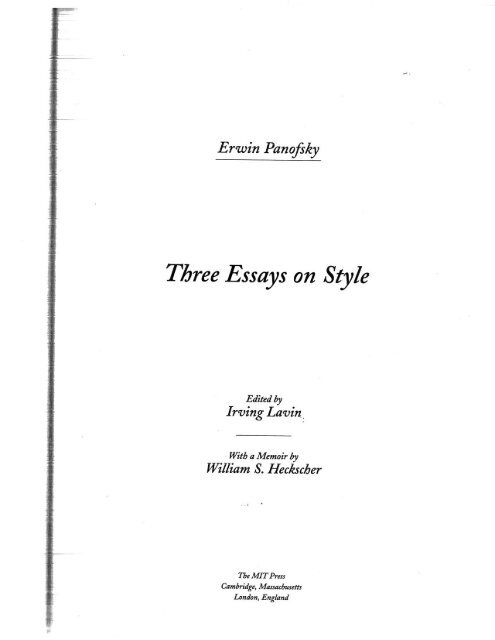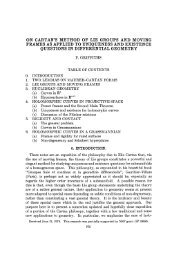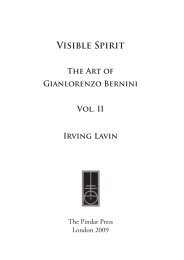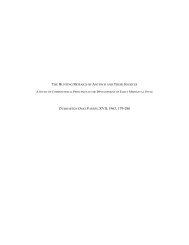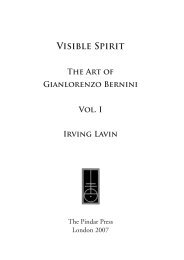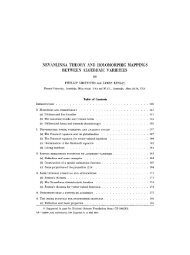T/yree Essays 012 Style - People - Institute for Advanced Study
T/yree Essays 012 Style - People - Institute for Advanced Study
T/yree Essays 012 Style - People - Institute for Advanced Study
You also want an ePaper? Increase the reach of your titles
YUMPU automatically turns print PDFs into web optimized ePapers that Google loves.
•<br />
Erwin Panoftky<br />
Three <strong>Essays</strong> on <strong>Style</strong><br />
Edited by<br />
Irv ing Lavin.,<br />
With a Memoir by<br />
William S. Heckscher<br />
, .<br />
ThtMITPms<br />
Cambridge, Massachusetts<br />
i..IJndon, England
Preface<br />
Introduction<br />
by l roing Lavin<br />
I What Is Baroque?<br />
Contents<br />
II. <strong>Style</strong> and Medium in the Motion Pictures<br />
m. The IdeologicalAntecedents of the Rolls-Royce Radiator<br />
Erwin Panoftky: A Curriculum Vitae<br />
by WJliam S. H"hcher<br />
Notes<br />
List of Illustrations<br />
Publication Notes<br />
About the Authors<br />
Name Index<br />
VII<br />
1<br />
17<br />
91<br />
127<br />
167<br />
197<br />
221<br />
229<br />
233<br />
237
Introduction<br />
Irving Lavin
Irving Lavin<br />
in particular, how to make sense out of history by giving it structure and<br />
meaning. They deal with essential aesthetic dispositions-the "Baroque" nature<br />
of seventeenth-century art, the "filmic" nature of the art of the motion<br />
picture, the "English" nature of the art of the British Isles-that manifest<br />
the significance of style in different aspects: chronological, technical, ethnic.<br />
Panofsky believed that certain <strong>for</strong>mal modes are "proper" to a given medium,<br />
that in a given time and place all works of art have certain features in common,<br />
despite individual and local variations, and that shifts from one such<br />
commonality to another-periodization, in other words-constitute the historical<br />
process. In our age of complexity and deconstruction, such an attitude<br />
may seem naive, or arrogant, or both. Yet, with training and experience (and<br />
a lot of mistakes, to be sure) art historians tend to be able to appreciate, date,<br />
and localize works of art just by looking at them. If we want to know why,<br />
we have to turn to the W6lfRins and Panofskys of the discipline <strong>for</strong> help.<br />
A further point, of special significance with respect to Panofsky's<br />
own development, arises partly from the circumstance that the essays were<br />
not intended to be professional academic tracts but were conceived originally<br />
as public lectures <strong>for</strong> nonspecialist audiences, a fact that certainly conditioned<br />
both their content (broad topics of general interest) and their <strong>for</strong>m (relatively<br />
brief and in<strong>for</strong>mal in tone).s However, it is also apparent that the choice of<br />
subjects and manner of treating them were affected by a particular turn of<br />
mind. The problems of style preoccupied Panofsky throughout his life; his<br />
first publication after his dissertation was a critique of W6lfRin titled "Das<br />
Problem des Stils in der bildenden Kunst."6 Reflecting his debt to the preceding<br />
generation, his earlier works on the topic are more abstract and theoretical<br />
than these very concrete, historical demonstrations, which reflect the<br />
mental shift Panofsky experienced after coming to America. The same may<br />
be said of his one other post-immigration paper devoted specifically to style,<br />
the better-known Gothic Architecture and Scholasticism, a lecture published as<br />
a separate volume and still in print/ in which Panofsky correlates <strong>for</strong>m and<br />
structure to a particular mode of reasoning and intellectual discourse. A<br />
change is also evident in Partofsky's approach to his subjects. In the first paper,<br />
he identifies and embraces as virtues certain egregious features of a great<br />
period style-sentimentality, frivolity, and even humor-that flouted the<br />
classical aesthetic canon and offended "serious" critics. In the second, he takes<br />
seriously a "frivolous" theme: the artistic development of a new, unabashedly<br />
popular, and commercial technique. In the third, he gives a frivolous spin to
Introduction<br />
an idea that Panofsky had seen become, especially in his native country,<br />
deadly serious: the definition of the inherent character of a millennia! national<br />
culture, the "genius" of a people. All these passionately felt and enchantingly<br />
devised arguments entail ironic inversions of conventional<br />
attitudes that might be expected from a traditional German historian of medieval<br />
and Renaissance art.<br />
It is important to bear in mind in reading these essays that matters<br />
of style are central to many of Panofsky's other interests, such as proportion<br />
theory, perspective, even Galileo and the "design" of the planetary orbits. 8<br />
M oreover, the subjects dealt with here also come up in other contexts: Durer<br />
and the technique of engraving, national and period styles in German Romanesque<br />
sculpture, and early Netherlandish painting. 9 The role of style in<br />
Panofsky's thought is by no means encompassed by the writings devoted expressly<br />
to the subject.<br />
Finally, be<strong>for</strong>e considering the essays individually, we may take note<br />
that two of them are the only occasions where Panofsky ventured into the<br />
domain of modern art: film and commercial design, the <strong>for</strong>mer in extenso,<br />
the latter en passant. 10<br />
Periodization is the underlying theme of the first work, whose significance<br />
may be gauged by the remarkable fact that the standard history of seventeenth-<br />
and early-eighteenth-century Italian art, RudolfWittkower'sArt and<br />
Architecture in Italy 1600-1750, first published in 1958, constantly refers to<br />
the Baroque but never seeks to define the term or describe the general characteristics<br />
of the period that justify its use. The; book is a magnum opus of<br />
erudition and an-historical perspicuity, and this conceptual silence bespeaks<br />
a certain shyness in the field as a whole with regard to what might be called<br />
high synthesis. The truth, I fear, is that while our knowledge of the Baroque<br />
has increased exponentially in the last half century, our understanding has<br />
not kept pace. What is Baroque, anyway? Many of us-and especially the<br />
specialists among us-if pressed to respond to that challenging question,<br />
would probably sputter, gasp, and take refuge in the <strong>for</strong>mulations provided<br />
by our heroic pioneer, Heinrich WolfHin, in his Principles 0/ Art History<br />
(1915). But Wolfllin was defining the first principles of a new discipline,<br />
whereas we are professional practitioners, too sophisticated, perhaps, to discuss<br />
first principles. Whatever the reason, I believe that one of the most important,<br />
and fundamentally new, contributions to the topic since WolfHin is<br />
s
Irving Lavin<br />
contained in the lecrure by Panofsky entitled "What Is Baroque?," which was<br />
written in 1934 and presented often <strong>for</strong> many years thereafterY Panofsky<br />
never published the piece and ultimately came to regard it as obsolete. 12 I<br />
sometimes wonder, in fact, whether "What Is Baroque?" was one of those<br />
papers that, as I have heard, Panofsky deliberately withheld from publication<br />
in order to have something available <strong>for</strong> the flood of guest lecrure invitations<br />
he received. A mimeographed text, evidently transcribed from Panofsky's<br />
typescript by a student at Vassar, where he gave the lecture at the conference<br />
in 1935, has always been available in various libraries, which is how I first<br />
encountered it when I was a graduate student at New York University's <strong>Institute</strong><br />
of Fine Arts in the early 1950s. 13<br />
I have long thought that the text should be published, despite its<br />
shortcomings, and the author's misgivings, partly because it documents a distinctly<br />
"transitional" phase in Panofsky's own development-elegant English<br />
even at that early date in the American half of his life, yet with traces of the<br />
long, complicated Germanic periods that, as he later astutely observed, the<br />
need to adapt to Anglo-Saxon usage expunged from his prose style. More<br />
important, however, Panofsky's way of considering a perennial and quintessentially<br />
art-historical problem from a broad, interdisciplinary point of view<br />
makes the essay particularly consonant with current attitudes in the discipline.<br />
Indeed, because of this method, the implications of Panofsky's response<br />
look well beyond the narrow purview of his question.<br />
To comprehend the significance of the substance of Pan of sky's argument,<br />
it should be recalled that Wolffi.in's analysis is based on a fundamental<br />
dichotomy between two opposing <strong>for</strong>mal systems, classic and Baroque. The<br />
essence of his concept lies not only in the five antinomic components of the<br />
contrasting systems, but also in the notion that they are not temporally fixed;<br />
they represent immanent, immutable poles of perception, between which all<br />
artistic vision inevitably oscillates-not <strong>for</strong> nothing did he call his book Principies<br />
of Art History. 14 Panofsky also conceives of style and its development in<br />
dialectical terms, starting from an underlying dichotomy, an interior discrepancy<br />
he found embedded in'the' art of the early Renaissance. There was on<br />
the one hand a renewed interest in antiquity, and on the other hand a quite<br />
nonclassical interest in naruralism-epitomized by the importation to Florence<br />
and influence of Hugo van der Goes's Portinari altarpiece; there was on<br />
the one hand mathematical perspective, and on the other hand a persistent<br />
6
IMJing La'Vin<br />
of Baroque sculpture and the modernity of caricature reflect recent, pioneering<br />
srudies by the then bright new star on the art-historical horizon, Rudolf<br />
Wittkower.18<br />
Panofsky's contribution was to bring together these myriad, more or<br />
less isolated observations, re<strong>for</strong>mulate them in his own image, and integrate<br />
them, via the process of contrast and reconciliation, into a coherent argument.<br />
The result was a comprehensive view that encompassed and gave focus<br />
to the entire development of European art from the Renaissance to the midnineteenth<br />
century (the death of Goethe, as he put it). Panofsky's view of the<br />
Baroque as part of one continuous arc of Western development that ended<br />
only with the Industrial Revolution and the rise of mass culture, anticipated<br />
much recent historical thought. Contemporary thinkers also share this reference<br />
to economic and social <strong>for</strong>ces as effecting historical change. But it is<br />
striking and symptomatic of the particular way in which he perceived the<br />
contemporary relevance of his own work that he ends his talk with an ironically<br />
brooding observation: that the unknown God or Devil who brought an<br />
end to the humanistic tradition of the Renaissance threatens the very existence<br />
of humankind in our own time. 19<br />
On the level of principle, it is clear that Panofsky's process of thesis<br />
versus antithesis followed by synthesis was a Hegelian transfiguration of the<br />
bipolar principles of Riegl and Wolffiin. But there are three essential differences.<br />
First, Panofsky's principles were not purely <strong>for</strong>mal modes, like Riegl's<br />
tactile and optic values, or Wolffiin's closed and open <strong>for</strong>m; and they were<br />
certainly not aesthetic categories related to quality judgments or taste. Concepts<br />
like classical antiquity, Gothic and mannerism, balance and harmony<br />
versus tension and conflict, while they evoke or correspond to distinctive <strong>for</strong>mal<br />
traits, are deeply embedded in the fabric of human society: war, religion,<br />
science, psychology, even-in the case of the Baroque-that special <strong>for</strong>m of<br />
wit to which Panofsky here accords the name "humor." And unlike interpreters<br />
who sought to instrumentalize the Baroque in terms of such notions as<br />
theatricality, or the Jesuit Counter Re<strong>for</strong>mation, Panofsky's categories are ultimately<br />
inseparable from the entire gamut of apparendy coincidental cultural<br />
values and social responses that used to be called the spirit of an age, the<br />
zeitgeist. 20 Second, Panofsky's polarities are not independent categories of<br />
perception and thought-timeless, built-in structures of the mind. Instead,<br />
they are specifically timebound, historical conditions whose manifestations<br />
8
INling ul'Uin<br />
word "Moving" in the title changed to "Motion," when it was described as<br />
"one of the most significant introductions to the aesthetics of the motion<br />
picture yet to be written, " 22 Already reprinted at least twenty-two times, it is<br />
by far Panofsky's most popular work, perhaps the most popular essay in modern<br />
art history. This unexampled success is the more astonishing given the<br />
author's traditional training and otherwise almost exclusive preoccupation<br />
with traditional "high" art. In fact, the essay offers a rare, if not unique, instance<br />
in which a sensitive and in<strong>for</strong>med "eye- (and later 'ear-') witness" comments<br />
extensively on the evolution of a revolutionary new technical invention<br />
into a high art. Panofsky himself cites as a comparable innovation in the history<br />
of human communication the development of printmaking in the<br />
fifteenth century, but we have no comparable analysis of its nature and significance<br />
by a contemporary observer.13<br />
Panofsky displays an amazing fund of knowledge-of plots, actors,<br />
directors, producers, filmic devices-which he obviously accumulated from<br />
an early age. He remembered the only Kino ("obscure and faintly disreputable")<br />
in all Berlin in 1905, when he was thirteen, and he watched the medium<br />
develop from its earliest infancy as a technical curiosity to a major<br />
international industry of great technical and artistic virruosity. In this essay,<br />
there<strong>for</strong>e, the private-life experience of an avid moviegoer becomes part of<br />
the intellecrual armament of a supremely articulate historian and theoretician<br />
of art. The circumstances of its origin are of great importance: it was not a<br />
<strong>for</strong>mal presentation to a scholarly audience, but a casual talk delivered in<br />
1934 to a group of Princeton amateurs intent on founding a film archive<br />
(ultimately one of the greatest in the world) at the Museum of Modern Art<br />
in New York.. 1• Panofsky elsewhere describes himself as having been then a<br />
lecturer at New York and Princeton Universities; he had just settled permanently<br />
in Princeton, and the following year he was appointed to the nascent<br />
<strong>Institute</strong> <strong>for</strong> <strong>Advanced</strong> <strong>Study</strong>.15 The occasion marked the rapport Panofsky<br />
had established with the liberal-minded, public-spirited, and WASPish social<br />
and cultural ambient then in the process of creating the portentous amalgam<br />
of European sophistication and American enthusiasm that would<br />
establish New York as a new world cultural center of modernism. Ui<br />
The genial, peculiarly American context from which the essay arose<br />
is reflected in its original title, "On Movies." This distinctly colloquial American<br />
term, which has no real counterpart in other languages,17 expressed the<br />
two essential points of Pan of sky's conception of the medium and its develop-<br />
10
Introduction<br />
ment, one social, the other aesthetic. Panofsky lays great stress at the outset<br />
on the fact that film was first and <strong>for</strong>emost a medium of popular entertainment,<br />
devoid of aesthetic pretension, which reestablished the "dynamic contact<br />
between art production and art consumption" that is "sorely attenuated,<br />
if not entirely interrupted, in many other fields of artistic endeavor." The<br />
"movies" were a genuine "folk art," and if they rose to the level of high art<br />
they did so largely by never losing their common touch. This unpretentious<br />
social aspect of Pan of sky's definition of the film is the substantive counterpart<br />
of his choice of the colloquial name <strong>for</strong> the medium.<br />
The second principle on which Panofsky's analysis is based corresponds<br />
to the aesthetic aspect of his title, movement. The essence of the medium<br />
lies in its having given movement to a record of the real world, an<br />
observation that, as he admits, seems banal until he states and proceeds to<br />
develop his binary definition of the motion picture as the "dynamization of<br />
space" and the "spatialization of time." Although he does not say so explicitly,<br />
it is evident that this <strong>for</strong>mulation suggesting an endemic interdependence of<br />
space and time, a sort of space-time continuum, owed much to the theory of<br />
relativity. An important corollary, however, is the integration of sound into<br />
this matrix, the spoken word being fatefully wedded to movement through<br />
the device of the close-up. Panofsky defines this sound-movement dimension<br />
of the space-time continuum as the "principle of coexpressibility." Much of<br />
the remainder of the essay is devoted to exploring the implications of these<br />
principles, including the dangers inherent in disregarding them, much like<br />
those attendant upon neglecting the roots of the medium in popular culture.<br />
In the third, final version of the paper· two complementary changes<br />
were introduced. The trace of colloquialism that remained in the "Moving"<br />
of the second tide was replaced by the purely <strong>for</strong>mal "<strong>Style</strong> and Medium in<br />
the Motion Picrures," which focuses entirely on the relationship between the<br />
technical properties of film and its expressive qualities. In the text, the social<br />
characterization retains its place, with some changes in wording at the beginning,<br />
but it becomes a kind of prelude to the now greatly expanded section<br />
dealing with the nature of the me'dium itself The personal chat on a modern<br />
<strong>for</strong>m of entertainment was thus trans<strong>for</strong>med into a proper theoretical essay<br />
on a <strong>for</strong>m of modern art. Balance is restored, however, in the last paragraphs,<br />
which deal with two points that lie at the crux of the matter: film's relation<br />
to society based on its commercial nature, and its relation to physical reality<br />
based on its technical nature. The requirement of communicability imposed<br />
11
Irving Lwin<br />
by the first relationship and the requirement of realism imposed by the second<br />
are the preconditions <strong>for</strong> style in this uniquely modern medium.<br />
To call the film essay "proper" is rather misleading, however. The<br />
tide and the content are more ambitious than in the original version, but<br />
perhaps the most important quality of the text remained undiminished: the<br />
whole argument, full of erudite references to old and new films as well as to<br />
works of traditional art, is presented with an impish grace and wit wholly in<br />
keeping with the popular narure of the theme as Panofsky conceived it. Panofsky<br />
moves between Betty Boop and Buster Keaton with the same breathtaking<br />
ease born of intimate knowledge as he does between Albrecht DUrer<br />
and the Gothic cathedral. The prose combines the urbanity and entertainment<br />
value of the New York" magazine with the philosophical depth and<br />
methodological rigor of a German university treatise. Even in its ultimate<br />
<strong>for</strong>m, then, the essay hovers in a sort of genre limbo somewhere between<br />
personal reminiscence, high journalism, <strong>for</strong>mal art criticism, and professional<br />
art history. From any of these points of view it is a rogue, and it marks the<br />
birth of a new literary star- in English, no less!<br />
The Rolls-Royce radiator raised <strong>for</strong> Panofsky the question of the<br />
ethnic component of style. While both the title and the content of the paper<br />
are remarkable, still more remarkable is the relationship between the two.<br />
Nowadays, the title would suggest something in the nature of a sociological<br />
disquisition on the taste and luxury of the English upper class, but one would<br />
be disappointed on two counts. The structure of English society is mentioned<br />
only incidentally, and the Rolls-Royce is mentioned only in the last, very<br />
brief paragraph. The body of the work is an audacious attempt to define the<br />
basic principle that inhabits English art, as well as other aspects of English<br />
culrure, from the early Middle Ages through the nineteenth century.<br />
Panofsky again finds an "antinomy of opposite principles," comprising here<br />
"a highly subjective emotionalism" that may even be termed "romantic," and<br />
"a severely <strong>for</strong>mal rationalism." He relates this bipolarity-as an incidental<br />
analogy, not as a causative "explanation"-to the peculiar "fact that social<br />
and institutional life in England ·is more strictly controlled by tradition and<br />
convention, yet gives more scope to individual 'eccentricity' than anywhere<br />
else."<br />
The fact that Panofsky engaged in this enterprise at all is profoundly<br />
rooted in his heritage of continental, especially German art history. Two major<br />
books, both by German scholars, had been devoted to the Englishness of<br />
12
Irving Lovin<br />
I hope that two salient characteristics of Pan of sky's style, intellectual and literary,<br />
will have emerged from this brief consideration of his own discussions<br />
of style. The first is that whether the subject is periodization, technique, or<br />
geo-ethnicity, Panofsky, unlike his predecessors, is never a pure <strong>for</strong>malist.<br />
<strong>Style</strong> <strong>for</strong> him inevitably has an expressive role, and he constantly invokes the<br />
subject matter of works of art, their "iconography-be it the new conception<br />
of martyrdom scenes in the Baroque, the narrative possibilities of the animated<br />
cartoon, or the "angelic" intricacies of the evangelist portraits in an<br />
Irish illuminated book. Indeed, it might be said that Panofsky's primary concern-his<br />
ultimate heuristic principle of interpretation-was to illustrate<br />
how style or expressive <strong>for</strong>m lends meaning to subject matter, and thus relates<br />
the work of art to the full range of extrastylistic factors that condition its<br />
creation. 3 ! After all, this interrelationship between style and meaning lies at<br />
the heart of perhaps his most familiar, and still indispensable, historical <strong>for</strong>mulation:<br />
that of the Renaissance as having achieved, after the destruction of<br />
Greco-Roman civilization, the reintegration of classical <strong>for</strong>m with classical<br />
content. 31<br />
The lapidary prose and especially the potent dose of humor evident<br />
throughout these essays are also vintage Panofsky-Panofsky in his American<br />
phase, be it noted, <strong>for</strong> neither of these things can be said of his earlier<br />
work in German.)J Concerning the first point, Panofsky himself described<br />
the trans<strong>for</strong>mation toward economy of thought and expression entailed by<br />
his adjustment to the English language used in his adopted country.34 What<br />
he did not mention is an equally profound trans<strong>for</strong>mation of his academic<br />
persona. Panofsky's wit had always been irrepressible and legendary, from<br />
cradle to grave, as it werej witness the immortal epitaph that he said came to<br />
him in a dream after spending an afternoon with his granddaughter:<br />
He hattd bahies, gardtning, and birds;<br />
But I()'/)ed a few adults, all dogs, and words. JS<br />
I speak here of the infusion of this personal quality into the normally solemn<br />
koine of scholarly discourse. The charm and humor that abound in almost<br />
everything he wrote in English were a product of his Americanization. They<br />
were his own invention, however, <strong>for</strong> they were no more native to previous<br />
American scholarship in art history than they were to European. And they<br />
brought a breath of fresh air to academe, both here and abroad.


